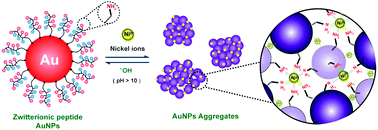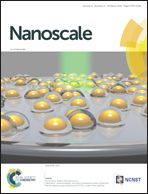Zwitterionic peptide-capped gold nanoparticles for colorimetric detection of Ni2+ †
Abstract
Zwitterionic nanoparticles are typically utilized as nanoprobes and delivery vehicles in nanomedicine and therapeutics due to their resistance to interferences. Their high stability also shows great potential to be applied in sensing applications. Here, we report a selective, sensitive and rapid colorimetric sensing of nickel ions (Ni2+) using zwitterionic polypeptide, EKEKEKPPPPC (EK)3, capped gold nanoparticles (AuNP-(EK)3). By taking advantage of the alternate carboxylic (–COOH)/amine (–NH2) groups, the zwitterionic peptide can function dually by being able to sense metal ions and maintain colloidal stability. Ni2+ can trigger the aggregation of the AuNP-(EK)3 nanoprobe, which results in a red-to-purple color change of the AuNP-(EK)3 solution. Our 40 nm AuNP-(EK)3 nanoprobe can detect Ni2+ as low as 34 nM within 15 min with a linear range of 60–160 nM, and is stable in soil, urine and water samples. We demonstrate that the aggregation mechanism of the nanoprobe is due to the interactions between the –NH2 group of glutamic acid at the N-terminus of the peptide and Ni2+, and the aggregation process is reversible. Furthermore, the slight modification of two amino acid sequences at the N-terminus allows the nanoprobe to retain its stability, even in a high ionic strength medium. We believe that by adjusting or extending the peptide sequences, new metal ion selective peptides could be created.



 Please wait while we load your content...
Please wait while we load your content...